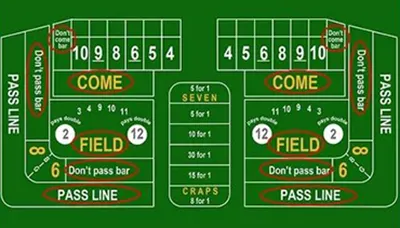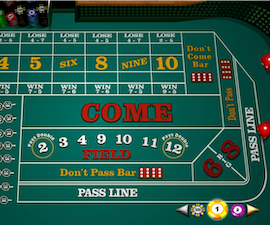How to Shoot Craps: A Step-by-Step Guide to Throwing Dice

So, you’ve decided to try your hand at shooting dice in a game of craps. Whether you're eyeing the dice like a seasoned player or still wondering if you need to say "abracadabra" before you roll, this guide has got you covered.
Let’s take the mystery out of the toss and the guesswork out of the game, so the next time you’re up, you can step into the shooter’s role with confidence—and maybe even a little swagger.
Step-by-Step Guide: Mastering the Process of Shooting Dice in Craps
Mastering the art of shooting dice in craps is a journey that requires precision and a clear understanding of the process. With this step-by-step guide, you’ll learn how to take control of the dice confidently, make strategic decisions, and maximize your chances of winning.
1. Preparing Dice for Craps

Ensure you have two standard six-sided dice before you begin. The dice should be in pristine condition: clean and free of any dirt or damage that might affect their roll. Inspect the dice to make sure they are perfectly balanced and have clear, unblemished numbers. Properly prepared dice are crucial for a fair game and accurate results.
2. How to Grip Dice for Optimal Craps Rolls
Hold the dice securely in one hand, placing your thumb and forefinger on opposite sides to maintain control. Your grip should be firm enough to keep the dice from slipping yet relaxed to avoid unnecessary tension or force. A good grip ensures that the dice are rolled with precision and consistency, preventing them from tumbling out of control.
3. Best Positioning for Craps Dice Rolling

Approach the craps table and position yourself at the edge where shooting is permitted, often referred to as the "shooter’s position." Ensure that you are behind the line designated for shooting, usually marked as the “come out” area. This position helps maintain the integrity of the roll and aligns you with the table’s rules for a proper shot.
4. Setting Up for a Perfect Dice Roll
Hold the dice in your dominant hand and take a comfortable stance that provides stability. Position your hand a few inches above the table surface, keeping the dice close to but not touching the table. This setup ensures that the dice will have enough height to bounce off the backboard and return to the playing area, facilitating a proper roll.
5. How to Throw Dice Effectively in Craps

Execute a smooth and controlled motion to roll the dice. Avoid excessive force; a moderate toss is typically sufficient for the dice to hit the backboard, which is designed to ensure a fair roll by causing the dice to bounce and mix up. The goal is to achieve a balanced roll that maintains randomness while following the rules of the game.
6. Mastering the Dice Release for Craps
As you roll, allow the dice to tumble and rotate in mid-air. A flick of the wrist will provide the necessary momentum for the dice to bounce off the backboard. The release should be smooth and deliberate, imparting just enough force to ensure that the dice land in the playing area without being too aggressive or weak.
7. What to Watch for After Rolling Dice in Craps
Carefully observe the dice as they land and come to a stop on the table. Ensure that the dice have settled completely before any results are assessed or bets are resolved. The outcome is considered valid only when the dice are stationary and fully on the table, as this confirms that the roll was fair and in accordance with the game’s rules.

Register a free gaming account to play this exciting game of Craps by Microgaming. (18+. Gamble responsibly)
Play NowA Simple Guide on How to Shoot Craps
In the exciting world of craps, understanding the game process is key to making informed bets and enjoying the action. From the initial come out roll to the final betting results, each step plays a crucial role in determining the outcome.
By familiarizing yourself with the sequence of events, you’ll be better equipped to navigate the game and increase your chances of success.
Step 1. Understanding the Come Out Roll in Craps
The game of craps begins with the come-out roll, where the shooter rolls the dice to determine the initial result. This first roll is crucial because it sets the stage for the rest of the game.
If the shooter rolls a 7 or 11, the Pass Line bet wins, and the round ends.
If the shooter rolls a 2, 3, or 12, it results in a "craps," and the Pass Line bet loses.
Any other number (4, 5, 6, 8, 9, or 10) becomes the "point" number for the next phase.
Step 2: Scope Out the "Pass Line"
Find the Pass Line on the table—it’s where all the action begins. Most players, especially newbies, bet here because it's simple and has a decent house edge. If you believe in your lucky touch, place your chips on the Pass Line.
Step 3: Make Your Bet (Like a Pro)
You’re betting on yourself here! By placing your chips on the Pass Line, you're hoping the dice do what they’re supposed to—bring you good fortune. Some pros will also tell you to make an Odds Bet after the point is set (but we’ll get to that later).
Step 4: The Roll—Time to Let It Fly
With dice in hand, you’re the shooter now. No pressure. You want a solid throw toward the back of the table. Keep it smooth, and let the dice hit the far wall. None of that 'one-hand fancy stuff'—the casino won’t like it. Throw like you mean it!
Step 5: The Come-Out Roll (Your Big Moment)
Now, here’s where strategy meets luck. Your first roll is the come-out roll, and you want to land a 7 or 11. Why? Because that means instant victory! But if you roll a 2, 3, or 12, you crap out—you lose, and it’s back to the drawing board. Any other number rolled becomes the point (4, 5, 6, 8, 9, or 10).
Step 6: The "Point" Strategy
If you rolled a point number, here's the deal: your job now is to hit that point again before you roll a 7. This is where the real strategy kicks in. The house edge is low if you play it smart. At this point, you should consider making an Odds Bet behind your original Pass Line bet. This is one of the few bets where the house has no edge! It’s a side bet that’ll pay out if you hit the point before a 7. The more you back up your Pass Line bet with Odds, the more you can win!
Step 7: Keep Rolling (Or Not)
After the point is set, keep rolling the dice until you hit your point number (win) or roll a 7 (lose). This is why many seasoned players will "take odds" or spread out a bit with Come Bets to cover more numbers.
Step 8: Stack the Odds in Your Favor
Let’s get strategic. Here’s the breakdown:
- Pass Line Bet is straightforward and gives you a 50/50 chance on the come-out roll.
- Odds Bet after the point is your secret weapon. The payout varies based on your point: 6:5 on 6 or 8, 3:2 on 5 or 9, and 2:1 on 4 or 10.
- Avoid Betting the Big 'Prop Bets' (like those center table sucker bets) because the house edge is high. Stick to the Pass Line and Odds.
Step 9: Win (or Keep Calm)
Did you hit your point? Collect those chips and bask in the glory. Didn’t? Well, Craps is a game of streaks—sometimes hot, sometimes cold. The key is staying in the game with smart bets, not chasing bad ones.
Bonus Tip: Know When to Step Away If you're on a roll, awesome! But set limits. Craps can be exciting, but keep an eye on your chips. Quit while you're ahead or when Lady Luck’s taking a break.
Now you’ve got strategy and swagger to take to the Craps table. Remember: roll smart, bet smart, and have fun!
